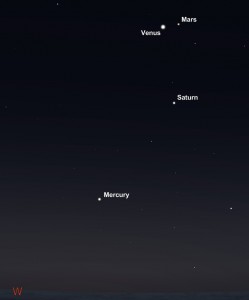These notes are intended to provide a casual skywatcher or someone already into amateur astronomy living in the Australian Capital Territory or in South East Queensland (Brisbane, the Gold Coast and the Sunshine Coast) with a short summary of what is happening in the night sky this week. Most of the information will also be useful for observers elsewhere in Eastern Australia.
There are a number of good passes by the International Space Station visible (at different times) which will be easily visible to the unaided eye from South East Queensland and Canberra this week. See below for the details of the passes. Instructions on how to obtain customised satellite viewing information for your location can be found here.
If you find this page of interest, you may wish to follow this website automatically using Twitter and the sites RSS Feed.
All week
The planets Mercury, Venus, Mars and Saturn continue to be visible above the Western horizon as evening twilight ends all week. The below finder chart is for Wednesday 18 August 2010 but gives you a general idea of what to expect for the week.

Jupiter is now easily visible low above the Eastern horizon from around 9pm throughout the week. It is the only bright starlike object in that part of the sky so you can’t mistake anything else for Jupiter.
Sunday 15 August 6 2010
Tonight, Brisbane residents will have the opportunity to see a very bright Iridium flare (a brief but spectacular flare of light that may only last 15 seconds as sunlight reflects off an Iridium satellite). There will be a flare tonight at 6.44pm. These flares are very location specific so it is best to check the prediction for your exact location.
Monday 16 August 6 2010
Moon reaches maximum libration (9.4 degrees) at 1 am.
Canberra residents will be able to watch the International Space Station pass overhead tonight without any need for optical aid. The pass starts at 7.04 pm and ends at 7.07 pm. The Space Station is forecast to reach almost the brightness of Venus (which is the bright star located above the Western horizon as evening twilight ends)! Further information and a finder chart can be found here.
Tuesday 17 August 2010
Saturn 0.3 degrees South West of NGC 4179
First Quarter Moon
Wednesday 18 August 2010
Canberra residents will be able to watch the International Space Station pass overhead tonight without any need for optical aid. The pass starts at 6.22pm and ends at 6.29pm. Further information and a finder chart can be found here. Most of Canberra will also have the opportunity to see a very bright Iridium flare (a brief but spectacular flare of light that may only last 15 seconds as sunlight reflects off an Iridium satellite). There will be a flare tonight at 6.41pm. These flares are very location specific so it is best to check the prediction for your exact location.
Comet Encke 1.4 degrees West of Mercury
Brisbane residents will be able to watch the International Space Station pass overhead tonight without any need for optical aid. The pass starts at 6.24pm and ends at 6.29pm. The Space Station is forecast to reach almost the brightness of Venus (which is the bright star located above the Western horizon as evening twilight ends)! Further information and a finder chart can be found here.
Friday 20 August 2010
Mercury stationary
Venus greatest elongation East (46 degrees)
Neptune at opposition
Saturday 21 August 2010
Tonight, Brisbane residents will have the opportunity to see a very bright Iridium flare (a brief but spectacular flare of light that may only last 15 seconds as sunlight reflects off an Iridium satellite). There will be a flare tonight at 6.16pm. These flares are very location specific so it is best to check the prediction for your exact location.
For Further Information
Planet and Moon Rise/Set Times
Planet and Moon rise/set times for 2010 can be found here on this website.
Customised Astronomy & Satellite Viewing information
Information on how to obtain customised astronomy & satellite viewing information for your location can be found here on this website.
Great Red Spot (Jupiter) viewing times
Information on when to see the Great Red Spot on Jupiter in 2010 can be found here on this website. Keep in mind that Jupiter is currently only visible in the morning sky.